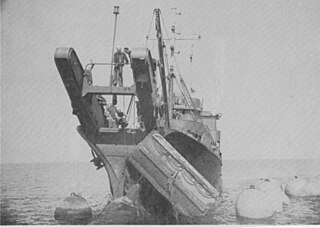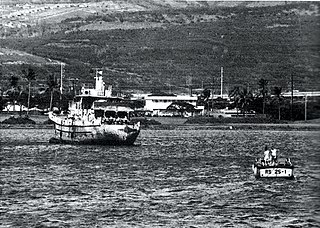
USS Etlah (YN-98/AN-79) was a Cohoes-class net laying ship built for the United States Navy during World War II. She was commissioned in April 1945 and spent her entire career in the Pacific Ocean. She was decommissioned in March 1947 and placed in reserve. She was recommissioned in August 1951 for Korean War service and remained active until May 1960. She was sold to the Dominican Republic in September 1976 as patrol vessel Cambiaso (P207). By 1994, Cambiaso had been removed from Dominican Navy service and hulked.

The TS Golden Bear is the training ship of the California State University Maritime Academy (CSUMA), a campus of the California State University. The first training ship of the then–California Nautical School was known as the Training Ship California State, then as the T.S. Golden State. Since then, there have been three ships to bear the name T.S. Golden Bear.
USS Ptarmigan (AM-376) was an Auk-class minesweeper acquired by the United States Navy for the dangerous task of removing mines from minefields laid in the water to prevent ships from passing. She was the only U.S. Navy ship named for the ptarmigan, a grouse with feathered feet, found in northern regions.
USS Skirmish (AM-303) was an Admirable-class minesweeper built for the United States Navy during World War II. She received four battle stars during World War II. She was decommissioned in December 1945 and placed in reserve. In February 1955, while still in reserve, her hull number was changed from AM-303 to MSF-303, but she was not reactivated. She was transferred to the Dominican Republic in January 1965 and renamed Separación (BM455). She was employed as a patrol vessel in Dominican Navy service and renamed Prestol Botello in 1976. Her pennant number was changed from BM454 to C454 during a 1995 refit. As of 2007, Prestol Botello remained in active service for the Dominican Navy.

USS Escape (ARS-6) was a Diver-class rescue and salvage ship commissioned by the U.S. Navy for service in World War II. She was responsible for coming to the aid of stricken vessels.

USS Kern (AOG-2) was a Patapsco-class gasoline tanker acquired by the United States Navy for the dangerous task of transporting gasoline to warships in the fleet, and to remote Navy stations.

USS Maquoketa (AOG-51) was a Patapsco-class gasoline tanker in service with the United States Navy from 1945 to 1947 and with the Military Sea Transportation Service from 1952 to 1957. She was sold for scrap in 1975.

USS Passaic (YN-113/AN-87) was a Cohoes-class net laying ship built for the United States Navy during World War II. She was commissioned in March 1945 and spent her entire career in the Pacific Ocean. She was decommissioned in March 1947 and placed in reserve. She was sold to the Dominican Republic in September 1976, as patrol vessel Calderas (P209). As of 2007, Calderas remained active in the Dominican Navy.
USS Marietta (YN-101/AN-82) was a Cohoes-class net laying ship commissioned at the end of World War II. Post-war she was deactivated, but then recommissioned during the Korean War era. After that service, she was struck from the Navy List and transferred to the Venezuelan Navy in 1962.

USS Teak (AN-35/YN-30) was an Aloe-class net laying ship which served with the U.S. Navy in the Pacific Ocean theatre of operations during World War II. She was assigned to serve the U.S. Pacific Fleet with her protective anti-submarine nets and earned two battle stars and other commendations for her bravery.

USS Sandalwood (YN-27/AN-32) was an Aloe-class net laying ship built for the United States Navy during World War II. She was later transferred to the French Navy as Luciole. She was stricken from the French Navy and sold to Malaysian owners, but her fate beyond that is unreported in secondary sources.
USS Mango (AN-24/YN-19) was an Aloe-class net laying ship which was assigned to serve the U.S. Navy during World War II with her protective anti-submarine nets.

USS Locust (YN-17/AN-22) was an Aloe-class net laying ship built for the United States Navy during World War II. She was later transferred to the French Navy as Locuste (A765). She was sold to Malaysian owners but sank after striking a reef off Cikobia Island, Fiji, on 30 July 1978. She was towing the former French ship Scorpion, which also sank.

USS Elder (AN-20/YN-15) was an Aloe-class net laying ship which was assigned to serve the U.S. Navy during World War II with her protective anti-submarine nets.
USS Buckthorn (YN-9/AN-14) was an Aloe-class net laying ship built for the United States Navy during World War II. Originally ordered as USS Dogwood (YN-3), she was renamed and renumbered to Buckthorn (YN-9) before construction began in December 1940. She was launched in March 1941, and completed in September 1941. Placed in service at that time without being commissioned, she was commissioned in December 1942, and decommissioned in August 1947. She was placed in reserve in 1947 and scrapped in 1976.

USS Buckeye (AN-13/YN-8) was an Aloe-class net laying ship in service with the United States Navy from 1942 to 1947. In the late 1970s and 1980s, she was used as a salvage training hulk.
USS Boxwood (YN-3/AN-8) was an Aloe-class net laying ship which was assigned to serve U.S. Navy ships and harbors during World War II with her protective anti-submarine nets.
USS Oneota (YN-110/AN-85) was a Cohoes-class net laying ship which was assigned to protect United States Navy ships and harbors during World War II with her anti-submarine nets. Her World War II career was short due to the war coming to an end, but she was retained post-war sufficiently long to participate in atomic testing at Bikini Atoll.
USS Passaconaway (YN-114/AN-86) – sometimes called USS Skakamaxon -- was a Cohoes-class net laying ship which was assigned to protect United States Navy ships and harbors during World War II with her anti-submarine nets. Her World War II career was short due to the war coming to an end, but, post-war, she continued salvage operations, including those at Bikini Atoll, before being struck from the Navy in 1947.

USS Waxsaw (YN-120/AN-91) was a Cohoes-class net laying ship which was assigned to protect United States Navy ships and harbors during World War II with her anti-submarine nets. Her World War II career was cut short due to the war coming to an end, but, post-war, she was reactivated and served the Navy until she was put into reserve and eventually transferred to Venezuela as Puerto Miranda.











